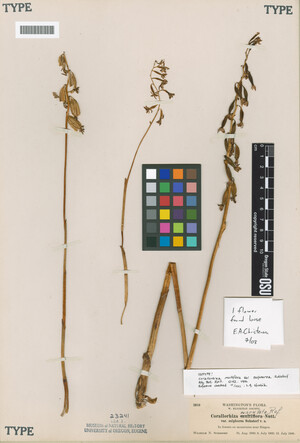Corallorhiza maculata var. maculata
|
|
|
|
Family: Orchidaceae
Summer Coralroot, more...Summer Coralroot
[Corallorhiza maculata f. flavida (M.Peck) Farw., moreCorallorhiza maculata f. punicea (Bartlett) Weath. & J.Adams, Corallorhiza maculata var. flavida (Peck) Cockerell, Corallorhiza maculata var. fusca Bartlett, Corallorhiza multiflora Nutt., Corallorhiza multiflora var. sulphurea Suksd., Corallorrhiza maculata var. flavida (M.E. Peck) Cockerell, Corallorrhiza maculata var. maculata , Corallorrhiza multiflora Nutt.] |
Inflorescences: floral bracts 0.5-1 × 0.5-9 mm, usually entire. Flowers: middle lobe of lip expanded slightly or not at all distally, ratio of width of dilated part to base of middle lobe less than 1.5; lip 3.3-7 × 1.5-4.5 mm; column curved, 3.3-5.5 × 0.7-1 mm at stigma; stigmatic surface elliptic-oblong to nearly square, 0.7 × 1 mm. Flowering May--Aug. Moist to dry coniferous and deciduous woods, and conifer plantations, often in florests with little other herbaceous cover; 0--3700 m; St. Pierre and Miquelon (variety unconfirmed); Alta., B.C., Man., N.B., Nfld. and Labr. (Nfld.), N.S., Ont., P.E.I., Que., Sask.; Ariz., Calif., Colo., Conn., Del., D.C., Ga., Idaho, Ill., Ind., Iowa, Maine, Md., Mass., Mich., Minn., Mont., Nev., N.H., N.J., N.Mex., N.Y., N.C., Ohio, Oreg., Pa., R.I., S.C., Tenn., Utah, Vt., Va., Wash., W.Va., Wis., Wyo. Perennial mycotrophic (saprophytic) herb 15 - 60 cm tall Leaves: none. Inflorescence: a single, erect, terminal, long-stalked, elongate, loose, spike-like cluster of of six to twenty, thick-stalked flowers with each flower subtended by an obscure, 0.5 - 9 mm long, 0.5 - 1 mm wide bract. Flowers: purple-brown to clear yellow with dark spots, about 1 - 3.5 cm wide, bilaterally symmetric with spreading sepals and petals, and one petal formed into a lip, but lacking a spur. The reproductive parts of stamens, stigma and style are fused into a 3.3 - 5.5 mm long column above the 0.5 - 1 cm long inferior ovary. Column curved, whitish yellow, spotted with purple, and 0.7 - 1 mm wide at stigma. Sepals: three, somewhat spreading, petal-like (larger than petals), brown to red or yellow (often darker near tips), 0.5 - 1.5 cm long, 1 - 2 mm wide, lance-shaped to linear, and with three lengthwise veins. Petals: three, with upper two usually curved forward above column. The two lateral petals are 0.5 - 1.2 cm long, 1 - 2 mm wide, linear to more lance-shaped, yellowish purple to tan, often red toward the tips, and usually spotted with purple. Lip 0.3 - 0.7 cm long, 1.5 - 4.5 mm wide, white and spotted with purple or crimson, elliptic to inversely egg-shaped but with three lobes. The two basal lateral lobes of the lip petal are small, rounded, slightly inrolled, and directed forward, while the large central lobe is oblong with two lengthwise ridges (lamellae) below the middle, and the tip expanded slightly or not at all. Fruit: several, stalked, drooping, 0.9 - 2.4 cm long, 0.5 - 0.9 cm wide, ellipsoid capsules with three lengthwise ridges, and remnant floral parts at apex. Flowering stem: single, erect, slender, hairless, somewhat fleshy, light brownish purple to yellowish, lacking leaves, but with a few, closed, tubular sheaths. This leafless structure terminated by flowers is called a scape and technically is not a true stem. Root system: lacking true roots, but with multiple-branched, coral-like rhizomes. Similar species: This is the only variety of Corallorhiza maculata in the Chicago Region. The other variety, C. maculata var. occidentalis, has longer floral bracts (1 - 2.8 mm) which are typically forked, the apex of the middle lobe of the lip is distinctly expanded or widened more than 1.5 times the width at its middle, the ovary is usually longer (0.9 - 1.3 cm), and the flowering stem tends to be more stout. See description page for the species, C. maculata, for more information on other similar species. Flowering: mid-July to mid-September Habitat and ecology: Uncommon, in upland mesic to dry-mesic woods such as oak or beech-maple woodlands. It is unable to tolerate dense shade as in mature forests, and populations have been known to increase or even reappear after burns. Occurence in the Chicago region: native Notes: See description page for C. maculata for more information. Etymology: Corallorhiza comes from the Greek words korallion, meaning coral, and rhiza, meaning root, in reference to the branching, underground rhizome, which has a similar appearance to coral. Maculata means spotted, which refers to the purplish spots on the flowers. Author: The Field Museum From Flora of Indiana (1940) by Charles C. Deam My specimens are all from the lake area except the one from Brown County. All grew in rather deep humus in black, black and white, or white oak woods. In addition to the counties shown on the map it has been reported from Jefferson, Lake, and La Porte Counties. The report from Jefferson County may probably be wrong since the author did not report Corallorrhiza Wisteriana which occurs there. |































































































